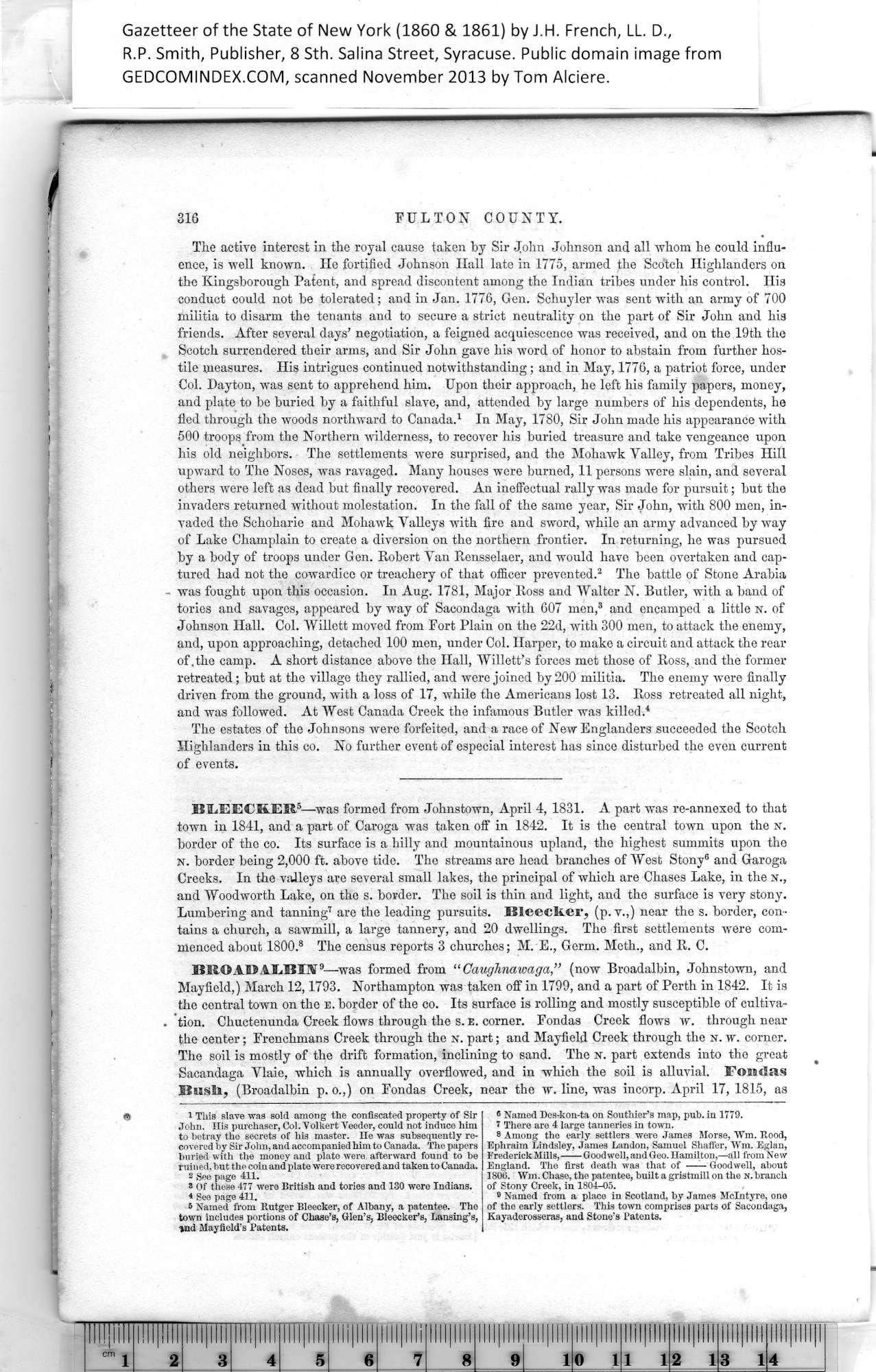|
316 FULTON COUNTY.
The active interest in the royal cause taken by Sir John Johnson and all whom he could influ¬
ence, is well known. He fortified Johnson Hall late in 1775, armed the Scotch Highlanders on
the Kingsborough Patent, and spread discontent among the Indian tribes under his control. His
conduct could not be tolerated; and in Jan. 1776, Gen. Schuyler was sent with an army of 700
militia to disarm the tenants and to secure a strict neutrality on the part of Sir John and his
friends. After several days’ negotiation, a feigned acquiescence was received, and on the 19th the
Scotch surrendered their arms, and Sir John gave his word of honor to abstain from further hos¬
tile measures. His intrigues continued notwithstanding; and in May, 1776, a patriot force, under
Col. Dayton, was sent to apprehend him. Upon their approach, he left his family papers, money,
and plate to be buried by a faithful slave, and, attended by large numbers of his dependents, he
fled through the woods northward to Canada.1 In May, 1780, Sir John made his appearance with
500 troops from the Northern wilderness, to recover his buried treasure and take vengeance upon
his old neighbors. The settlements were surprised, and the Mohawk Yalley, from Tribes Hill
upward to The Noses, was ravaged. Many houses were burned, 11 persons were slain, and several
others were left as dead but finally recovered. An ineffectual rally was made for pursuit; but the
invaders returned without molestation. In the fall of the same year, Sir John, with 800 men, in¬
vaded the Schoharie and Mohawk Yalleys with fire and sword, while an army advanced by way
of Lake Champlain to create a diversion on the northern frontier. In returning, he was pursued
by a body of troops under Gen. Robert Yan Rensselaer, and would have been overtaken and cap¬
tured had not the cowardice or treachery of that officer prevented.2 The battle of Stone Arabia
- was fought upon this occasion. In Aug. 1781, Major Ross and Walter N. Butler, with a band of
tories and savages, appeared by way of Sacondaga with 607 men,3 and encamped a little n. of
Johnson Hall. Col. Willett moved from Fort Plain on the 22d, with 300 men, to attack the enemy,
and, upon approaching, detached 100 men, under Col. Harper, to make a circuit and attack the rear
of .the camp. A short distance above the Hall, Willett’s forces met those of Ross, and the former
retreated; but at the village they rallied, and were joined by 200 militia. The enemy were finally
driven from the ground, with a loss of 17, while the Americans lost 13. Ross retreated all night,
and was followed. At West Canada Creek the infamous Butler was killed.4
The estates of the Johnsons were forfeited, and a race of New Englanders succeeded the Scotch
Highlanders in this co. No further event of especial interest has since disturbed the even current
of events.
BUEECK.ER5—was formed from Johnstown, April 4, 1831. A part was re-annexed to that
town in 1841, and a part of Caroga was taken off in 1842. It is the central town upon the n.
border of the co. Its surface is a hilly and mountainous upland, the highest summits upon the
n. border being 2,000 ft. above tide. The streams are head branches of West Stony6 and Garoga
Creeks. In the valleys are several small lakes, the principal of which are Chases Lake, in the n.,
and Woodworth Lake, on the s. border. The soil is thin and light, and the surface is very stony.
Lumbering and tanning7 are the leading pursuits. Bleeelies*, (p. v.,) near the s. border, con¬
tains a church, a sawmill, a large tannery, and 20 dwellings. The first settlements were com¬
menced about 1800.8 The census reports 3 churches; M. E., Germ. Meth., and R. C.
BROAUALBISf9—was formed from “Caughnawaga,” (now Broadalbin, Johnstown, and
Mayfield,) March 12,1793. Northampton was taken off in 1799, and a part of Perth in 1842. It is
the central town on the e. border of the co. Its surface is rolling and mostly susceptible of cultiva-
. tion. Chuctenunda Creek flows through the s. e. corner. Fondas Creek flows w. through near
the center; Frenchmans Creek through the n. part; and Mayfield Creek through the n. w. comer.
The soil is mostly of the drift formation, inclining to sand. The sr. part extends into the great
Sacandaga Ylaie, which is annually overflowed, and in which the soil is alluvial. F©ltc!a§
BilSla, (Broadalbin p. o.,) on Fondas Creek, near the w. line, was incorp. April 17, 1815, as
|
® Named Des-kon-ta on Southier’s map, pub. in 1779.
7 There are 4 large tanneries in town.
8 Among the early settlers were James Morse, Wm. Rood,
Ephraim Lindsley, James Landon, Samuel Shaffer, Wm. Eglan,
Erederick Mills,-Goodwell, and Geo. Hamilton,—all from New
England. The first death was that of Goodwell, about
1806. Wm. Chase, the patentee, built a gristmill on the n. branch
of Stony Creek, in 1804-05.
8 Named from a place in Scotland, by James McIntyre, one
of the early settlers. This town comprises parts of Sacondaga,
Kayaderosseras, and Stone’s Patents. |
1
This slave was sold among the confiscated property of Sir
John. His purchaser, Col. Volkert Veeder, could not induce him
to betray the secrets of his master. He was subsequently re¬
covered by Sir John, and accompanied him to Canada. The papers
buried with the money and plate were afterward found to be
ruined, but the coin and plate were recovered and taken to Canada.
2
See page 411.
3
Of these 477 were British and tories and 130 were Indians.
4
See page 411.
5
6 Named from Rutger Bleecker, of Albany, a patentee. The
6
town includes portions of Chase’s, Glen’s, Bleecker’s, Lansing’s,
7
md Mayfield’s Patents.
|
